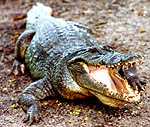NILE CROCODILE

How to Recognize
The Nile crocodile is Africa’s biggest reptile, reaching lengths of up to 20 feet.
It has a lizard-like shape and a scaly hide (which is highly sought after by poachers).
They are olive or dull gray in color, and they have powerful jaws and tails.
A crocodile will grow between 2,000 - 3,000 teeth in its lifetime.
Crocodiles can be distinguished from alligators by their long narrow snout.
Habitat
Nile crocodiles are found in freshwater lakes, rivers, swamps, and brackish water.
Behavior
Nile crocodiles like to bask in the sun, usually with their mouths open to cool off.
They can stay submerged with only their eyes and nostrils above the surface, waiting to ambush prey.
They live in large communities ranging from a few dozen to a few hundred with the largest crocodiles being the most dominant.
They engage in no group behaviors other than large feeding frenzies, and they rarely venture far from the water.
Breeding
Nile crocodiles mate late in the year, with the female laying her eggs about two months after copulation. She digs a nest hole and lays a few dozen chicken-sized eggs. The incubation period is 2˝ to 3 months.
Once they hatch, she carries the young in her mouth to an out-of-the-way, backwater area to protect them for up to two years. After that time period, the young become independent.
Feeding
Strictly carnivorous. Smaller crocodiles eat mainly fish or snatch swimming birds. For adult crocodiles, virtually any animal is fair game. They'll eat antelope, livestock, baboons, hyenas, impalas, and even big cats. They take many migrating wildebeests and zebras crossing at the Mara and Talek Rivers, and they are even responsible for hundreds of human deaths every year.
When an animal gets too close, the crocodile will lunge with incredible power and speed being propelled by its massive tail. It drags its victim underwater and drowns it. To eat, it clamps on the flesh and rolls over and over until it twists off a hunk of meat. Several crocodiles may gather at one floating carcass.
Enemies
Occasionally lions. But adult crocodiles have no real enemies, although territorial disputes between males can cause serious injuries. Hippos will nudge them off a sandbank and even bite one in half if it threatens a calf. For a young crocodile to reach maturity, it must first survive being eaten by birds, fish, and larger crocodiles.
TOP OF PAGE
Copyright © 2002, Dawn M. Dalton.
All rights reserved.
**LINKS**
WHERE?
WHY?
ITINERARY
PLAN YOUR TRIP
GETTING THERE
LONDON
KENYA
UGANDA
SAFETY
ITEMS BOUGHT
STAYING HEALTHY
COMMENTS
HOME
BHS HOME
---Animal Facts--
Baboon
Buffalo
Cheetah
Chimpanzee
Crocodile
Eland
Elephant
Gazelle
Giant Forest Hog
Giraffe
Gorilla
Hippopotamus
Hyena
Hyrax
Impala
Jackal
Lion
Mongoose
Monkey
Ostrich
Rhinoceros
Topi
Uganda Kob
Warthog
Waterbuck
Wildebeest
Zebra